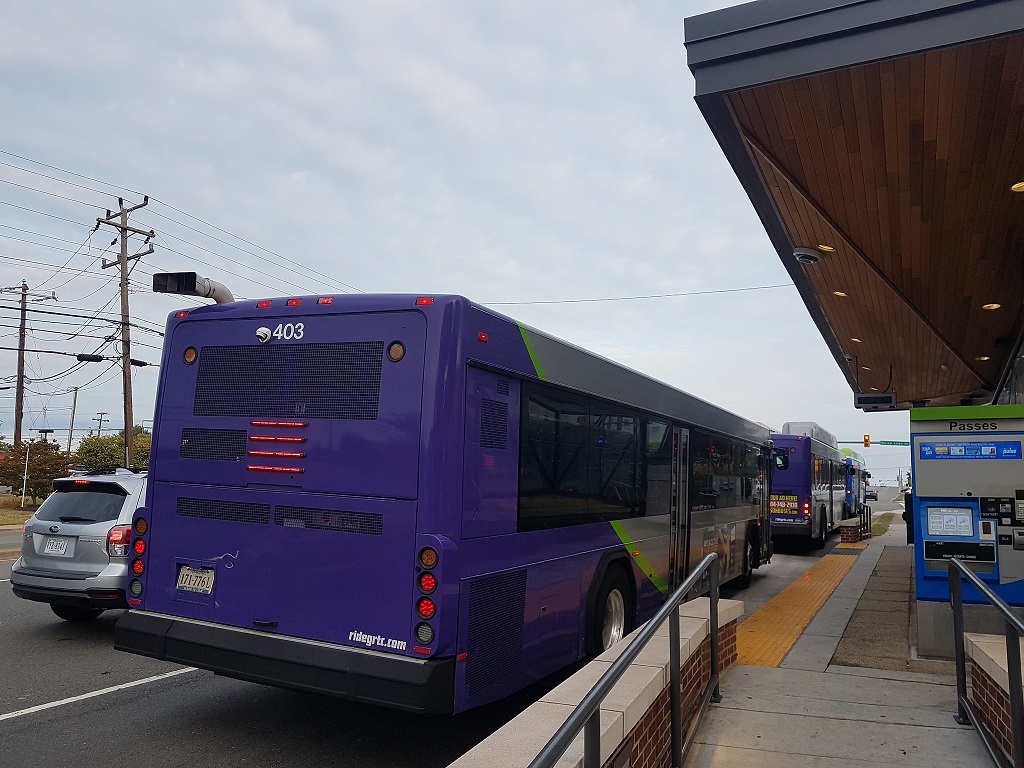Increasing overall reliability, creating partnerships, and making our public transit system truly regional are among the foremost goals of new GRTC CEO Julie Timm.
The new CEO of Greater Richmond Transit Co. has a vision of how to build on its recent breakthrough success of increased ridership, and it involves boosting regional commitment.
CEO Julie Timm, a Hampton Roads native, returned to Virginia after serving three years as the chief development officer for Nashville Metropolitan Transit Authority and Regional Transportation Authority of Middle Tennessee. On September 23, she turned her focus toward continuing the growth of public transportation in the Richmond area. GRTC is increasing its numbers of passengers, dodging a national trend of declining ridership.
From 2014 to 2017 bus ridership nationally dropped by more than half a billion riders, according to a 2017 report by the National Transit Database. But GRTC reported over 16 percent growth in the past fiscal year, according to its ridership trends report.
Timm wants the regional network to become more dynamic and target cluttered streets.
“We definitely have traffic issues here. But I think this is the right time to be addressing them,” she said. “If you wait until you have gridlocked traffic to try and address where the cars go, the cars are already here, and you can’t address it anymore.”
In an interview with Capital News Service, Timm detailed five key components that she thinks will help the region build its public transportation and offset vehicle congestion: partnerships, developing a true regional transportation system, investment from local governments, improving service reliability, and transit-centered development.

Forming Partnerships
Timm acknowledged Richmond’s recent double-digit population growth and its impact on traffic. She believes it is vital that GRTC connects with local and state government, educational institutions, public services, and private businesses to ensure that as the city grows, so does the accessibility to transportation services.
“If we don’t address how to move in an integrated way of all the different modes and how they share our limited infrastructure we can find ourselves gridlocked,” Timm said. “When you have the city or the state, or you have agencies who provide benefits to people for transportation, it reduces their barriers to be able to work, live, and play.”
For instance, with the partnership between GRTC and Virginia Commonwealth University, VCU students, faculty, and staff can ride the bus for free through a three-year deal. The university sealed the negotiation in June for $4.6 million, paid to GRTC in three annual, increasing payments.
According to VCU, over 95 percent of students and employees expressed support for continuing the GRTC service. The VCU community accounts for approximately 12 percent of GRTC’s total ridership, averaging 87,400 trips a month, the university said.
Partnerships like this help with vehicle congestion and also provide economic relief to citizens, Timm said.
“To be able to provide those benefits to people, it supports their ability to maintain their housing and their jobs and their education,” she said. “I just can’t speak highly enough about how important it is for people to come on board and provide those benefits to the community in partnership with GRTC.”

Regional Transportation System
GRTC serves the city of Richmond, and Henrico and Chesterfield counties. The organization is “handcuffed” because it is not an independent authority, Timm said. It operates under policies set by its Board of Directors, which consists of six members who serve one-year terms but are eligible for annual reappointment. Three are appointed by Richmond City Council; three are appointed by the Chesterfield Board of Supervisors.
The organization’s internal structure restrains its expansion, Timm said, and those issues have to be addressed in order to become a true regional transportation authority — or to partner with one.
“How we do that and how we move forward is something that needs to be established by the board and by our partners and by the state legislature in combination,” she said.
Timm said the groundwork must begin soon. “I’m hoping that we can have an answer over the next year in the development of a regional system that we can all embrace, we can all buy into and that everyone’s voice can be heard in it,” she said.
Investment from Local Government
GRTC generates revenue from bus fares and through advertising. The agency also receives money from federal, state, and local government entities such as the Federal Transit Administration, Virginia Department of Rail and Public Transportation, Richmond, Henrico, and Chesterfield. In some cases, money that comes from these sources can only be used for certain purposes.
But it is local funding from the districts covered by GRTC that is so vital for the company’s growth.
“We can’t function without that local funding because the money that we receive from state and federal sources requires a local match,” she said.
Timm pointed to Henrico as an example of how impactful local funding can be. Henrico recently budgeted its largest transit investment in 25 years, resulting in a 400 percent increase in the county’s ridership across all routes, according to GRTC’s 2018 annual report.

Reliability of the Service
A big challenge Timm believes GRTC faces is the perception of public transportation. The organization is working to change those views.
“People, sometimes, when they think about public transit, they think about the buses from 50 years ago,” she said. “They think about the school buses they rode that used a lot of diesel.”
Providing a reliable service that offers accessibility, safety, and consistency is the key Timm believes will help change the culture of public transportation.
“To have that level of frequency, that level of reliability, you will see people respond to it and people will start using it,” she said.
Rider Marina Williams said she celebrates the efficiency of the Pulse line, which runs every 10 minutes in the day over a 7.6-mile loop through Richmond and parts of Henrico. Williams said the other lines aren’t as convenient.
“I wish they had more buses on some routes,” Williams said. “It is very inconvenient to rely on buses every 30 minutes.”
Church Hill resident Marcel Cheatham agreed that the Pulse is a good service and that other lines are plagued by too many delays. “It takes me two hours to get to work and two hours to get back; the buses don’t stop frequently enough,” he said. “They need more buses.”
Timm agreed that many routes need to run more frequently and for longer hours.
“Of course, we can only provide as much service as we have funding for and for which we can show there is good demand to serve our current and future riders,” she said.
She said they are looking for opportunities to increase service to help passengers access a variety of resources.

Timely Planning of City Development
As the city population grows, so do its businesses, services, housing and infrastructure. Timm urges local leaders and developers to include and prioritize transportation access in their planning. Timm hopes development will target high density corridors where GRTC already has infrastructure in place or can connect to it.
“As we look to grow, and as we look to provide that access, think about mobility first, think about it as part of an integral part of the process. Not later,” she said.
Timm appreciated that Richmond Mayor Levar Stoney factored in public transportation in the Navy Hill redevelopment project with the proposed GRTC Transit Center. The project is still under review by Richmond City Council, but it includes a 65,000-square-foot connection hub for bus passengers that would replace the current temporary transfer center on 9th Street. GRTC was already seeking a large space to build a “multi-modal transportation hub” that could help streamline and coordinate scheduling and provide a secure place for waiting passengers.
“I think it is amazing and exciting that it is part of the conversation,” Timm said. “Too many times you see development and infrastructure and cities grow without having the conversation for how to embrace transit.”
GRTC has concluded the first stage of the Greater RVA Transit Vision Plan and is now under consultant review before the second stage starts, according to spokesperson Carrie Rose Pace. Part of the review is identifying incremental goals that can be implemented in the next five to six years over current service areas in Chesterfield, Henrico, and Richmond, Rose Pace said.
Timm’s watch is just beginning, but she is optimistic that GRTC can provide the public transportation Richmond wants and needs.
“It’s important to show that when you provide good, frequent, reliable transit … people will use it,” she said. “Slowingly reducing the barriers of how public transportation is perceived will help the growth of ridership.”
Written by Mario Sequeira Quesada, Capital News Service. Top Photo: Pulse arriving at Willow Lawn Station, by Mario Sequeira Quesada, via CNS



